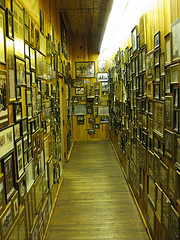What's the best album art size?
December 05, 2011 in album art by Dan Gravell

Your music collection's album art can be stored in a variety of sizes. With the new variety of devices with which you can listen to music, from tiny smart phones to enormous wide screen TVs, which size should you choose?
There are two points to consider: the size of your artwork, and its internal quality. These are different things. They are sometimes known together as resolution, but pixel and spatial resolution are separate concepts. This article will concentrate on pixel resolution, i.e. its size.
Historically the most common sizes for artwork have been 300x300 pixels and, laterly, 500x500. These are the sizes most music information databases store album artwork at. However, with newer, larger screen displays these images are beginning to look rather inadequate.
Check out my tutorial of how to change album art size with bliss!
So which size should I choose?
But knowing you can resize your music is of no help in determining which size to aim for! The truth is, your target size should depend on the largest display you play music (and can visualise album art) through. Your target artwork size should be a function of the screen real estate available in your music players. Higher resolution music players mean higher resolution art. Here's a rough guide as to what sizes you should be aiming for:
- Personal MP3 players e.g. iPod, smartphones - aim for small/medium size images of around 300x300 pixels. The higher resolution players are around 800 pixels in one dimension, so 300x300 leaves just under half the screen for the artwork.
- Tablets e.g. iPad - Aim for medium/large images of 500x500 and larger.
- Computer based software e.g. iTunes, Winamp - depending on the size of your player window, aim for medium/large images of 500x500 are larger.
- Large TVs - Aim for large images of 900x900 pixels and larger. Again, this depends on the resolution of your TV's software and the screen real estate afforded to your artwork.
But what if you have many of these devices? A TV for browsing at home, a computer in your office and a smart phone for when you are out-and-about? The ideal solution is to aim for the largest resolution you need and use that. Well-behaved music player software should simply scale down any image to the player's size.
There's always a "but...."
Unfortunately, there are a couple of reasons why using the largest art and hoping your player resizes it may not work. First, some music players have constraints that prevent them from displaying any art over or under a given size. If you go for large art in the vain hope your smart phone will resize it, this may not happen. Your-mileage-may-vary, so consult your music player's documentation and online communities (or just give it a try!).
The second reason this might be undesirable is that the larger art will take up more storage space. This is most likely to affect portably devices with less storage space. Sure, storage is cheap, but bear in mind that this image, if embedded, will be duplicated multiplied by the number of tracks in each album. So, you may notice a difference.
If either of these limitations affect your music library one way around it, assuming you have plenty of storage in your home network, is to maintain separate copies of your music library for portable devices (which are more likely to be the players with the issue). You can also take advantage of converting lossless FLAC files to lossy compressed music to save further storage space.
Organizing separate music libraries becomes the next headache, but I have a tool for that...
I hope this article has helped you choose a size for your album art!
Interested in music library management?
Acquiring, storing, organising and securing computer audio. It's all in the Music Library Management ebook, downloadable via email.
Thanks to daveynin for the image above.

